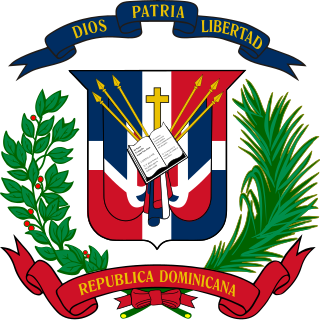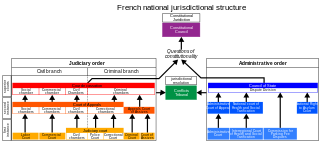Related Research Articles
Administrative law is a division of law governing the activities of executive branch agencies of government. Administrative law includes executive branch rule making, adjudication, and the enforcement of laws. Administrative law is considered a branch of public law.

In law, common law is the body of law created by judges and similar quasi-judicial tribunals by virtue of being stated in written opinions.
Case law, also used interchangeably with common law, is law that is based on precedents, that is the judicial decisions from previous cases, rather than law based on constitutions, statutes, or regulations. Case law uses the detailed facts of a legal case that have been resolved by courts or similar tribunals. These past decisions are called "case law", or precedent. Stare decisis—a Latin phrase meaning "let the decision stand"—is the principle by which judges are bound to such past decisions, drawing on established judicial authority to formulate their positions.

The legal system of Canada is pluralist: its foundations lie in the English common law system, the French civil law system, and Indigenous law systems developed by the various Indigenous Nations.

The primary and fundamental statement of laws in the Russian Federation is the Constitution of the Russian Federation. Statutes, like the Russian Civil Code and the Russian Criminal Code, are the predominant legal source of Russian laws.

Dominican law theorists make a fundamental distinction between primary sources of law, which can give rise to binding legal norms, and secondary sources, sometimes called authorities. The primary sources are enacted law and custom, with the former overwhelmingly more important. Sometimes, “general principles of law” are also considered a primary source. Authorities may have weight when primary sources are absent, unclear, or incomplete, but they are never binding, and they are neither necessary nor sufficient as the basis for a judicial decision. Case law and the writings of legal scholars are as such secondary sources.

French law has a dual jurisdictional system comprising private law, also known as judicial law, and public law.

The law of Brazil is based on statutes and, partly and more recently, a mechanism called súmulas vinculantes. It derives mainly from the civil law systems of European countries, particularly Portugal, the Napoleonic Code and the Germanic law.

In most legal jurisdictions, a supreme court, also known as a court of last resort, apex court, and highcourt of appeal, is the highest court within the hierarchy of courts. Broadly speaking, the decisions of a supreme court are not subject to further review by any other court. Supreme courts typically function primarily as appellate courts, hearing appeals from decisions of lower trial courts, or from intermediate-level appellate courts.

Law in the state of Louisiana is based on a more diverse set of sources than the laws of the other 49 states of the United States. Private law—that is, substantive law between private sector parties, principally contracts and torts—has a civil law character, based on French and Spanish codes and ultimately Roman law, with some common law influences. Louisiana's criminal law largely rests on American common law. Louisiana's administrative law is generally similar to the administrative law of the federal government and other states. Louisiana's procedural law is generally in line with that of other U.S. states, which in turn is generally based on the U.S. Federal Rules of Civil Procedure.
Sources of law are the origins of laws, the binding rules that enable any state to govern its territory.

The law of California consists of several levels, including constitutional, statutory, and regulatory law, as well as case law. The California Codes form the general statutory law, and most state agency regulations are available in the California Code of Regulations.
In most legal systems of the Spanish-speaking world, the writ of amparo is a remedy for the protection of constitutional rights, found in certain jurisdictions. The amparo remedy or action is an effective and inexpensive instrument for the protection of individual rights.
The law of Finland is based on the civil law tradition, consisting mostly of statutory law promulgated by the Parliament of Finland. The constitution of Finland, originally approved in 1919 and rewritten in 2000, has supreme authority and sets the most important procedures for enacting and applying legislation. As in civil law systems in general, judicial decisions are not generally authoritative and there is little judge-made law. Supreme Court decisions can be cited, but they are not actually binding.

The legal system of Puerto Rico is a mix of the civil law and the common law systems.

The Federal Constitution of the United Mexican States of 1857, often called simply the Constitution of 1857, was the liberal constitution promulgated in 1857 by Constituent Congress of Mexico during the presidency of Ignacio Comonfort. Ratified on February 5, 1857, the constitution established individual rights, including universal male suffrage, and others such as freedom of speech, freedom of conscience, freedom of the press, freedom of assembly, and the right to bear arms. It also reaffirmed the abolition of slavery, debtors' prisons, and all forms of cruel and unusual punishment such as the death penalty. The constitution was designed to guarantee a limited central government by federalism and created a strong national congress, an independent judiciary, and a small executive to prevent a dictatorship. Liberal ideals meant the constitution emphasized private property of individuals and sought to abolish common ownership by corporate entities, mainly the Catholic Church and indigenous communities, incorporating the legal thrust of the Lerdo Law into the constitution.

The law of the United States comprises many levels of codified and uncodified forms of law, of which the most important is the nation's Constitution, which prescribes the foundation of the federal government of the United States, as well as various civil liberties. The Constitution sets out the boundaries of federal law, which consists of Acts of Congress, treaties ratified by the Senate, regulations promulgated by the executive branch, and case law originating from the federal judiciary. The United States Code is the official compilation and codification of general and permanent federal statutory law.
The Mexican Federal Judicial Weekly contains the published jurisprudencias of the judiciary of Mexico.
The law of Bolivia includes a constitution and a number of codes.
The Judiciary of Mexico officially the Judicial Power of the Federation is one of the three branches of government in Mexico, and the sole federal judiciary power. It is composed of the Supreme Court of Justice of the Nation, which serves as its highest court, the Federal Judiciary Council, the Federal Electoral Tribunal, regional courts, circuit and appellate collegiate courts, and district courts.
References
- 1 2 3 4 5 6 7 8 9 10 11 12 13 14 15 LLRX 2008.
- 1 2 3 Avalos 2013, p. 12.
- ↑ Serna de la Garza 2009, pp. 141–144.
- ↑ Avalos 2013, p. 16.
- 1 2 3 Serna de la Garza, José María (2009). "The Concept of Jurisprudencia in Mexican Law". Mexican Law Review . 1 (2): 144–145.
- ↑ Torres Landa R., Juan Francisco; Guerrero R., Omar; Zacarías F., Humberto (2002). "Mexico". International Civil Procedure. Vol. 2. p. 121. ISBN 978-1-4357-0227-1.
- ↑ López Ayllón, Sergio; García García, Adriana; Fierro Ferráez, Ana Elena (2015). "A Comparative-Empirical analysis of administrative courts in Mexico". Mexican Law Review . 7 (2): 3–35. doi: 10.1016/S1870-0578(16)30001-4 .
- 1 2 Avalos 2013, p. 13.
- ↑ Merryman, John Henry (2007). The Civil Law Tradition: An Introduction to the Legal Systems of Europe and Latin America (3rd ed.). Stanford University Press. pp. 56–60. ISBN 978-0-8047-5569-6. LCCN 2007003956.
- ↑ Merryman 2007, p. 91.
- ↑ Avalos 2013, p. 2.
- ↑ Merryman 2007, p. 92.
- ↑ Avalos 2013, p. 11.
- Vargas, Jorge A. (27 February 2008). "Mexico and its Legal System". Law Library Resource Xchange. OCLC 212411937 . Retrieved 9 October 2013.
- Avalos, Francisco A. (2013). The Mexican Legal System: A Comprehensive Research Guide (3rd ed.). William S. Hein & Co. ISBN 978-0-8377-3951-9. LCCN 2013936122.